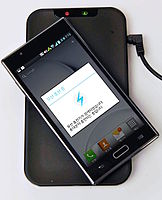
Photo from wikipedia
Static energy meters have shown errors beyond the standards due to conducted electromagnetic interference of pulsed currents. This was observed in several case studies and confirmed by laboratory experiments, which… Click to show full abstract
Static energy meters have shown errors beyond the standards due to conducted electromagnetic interference of pulsed currents. This was observed in several case studies and confirmed by laboratory experiments, which showed errors up to 2675%. The extent of this interference case is unknown, because there is limited information about the waveforms occurring in the real on-site scenarios. This article aims to detect critical waveforms in on-site surveyed data that have similar characteristics as the pulses that resulted in metering errors. The time-domain parameters of the laboratory experiments that show static energy meter interference are compared to the on-site waveform data using an interpolation based on an inverse weighting distance function. Using this approach, the waveform characteristics are compared, and an error is estimated. This approach was satisfactorily validated using data from validation experiments that shows a correct estimation of the actual error according to the permissible limits for energy metering for all validation indices. The performed on-site surveys show the existence of nonlinear waveforms. During the survey of three sites for ten days, 19 531 waveforms were captured, of which 14 487 indicate large nonlinearities and 379 are estimated to produce metering errors up to 925%.
Journal Title: IEEE Transactions on Electromagnetic Compatibility
Year Published: 2021
Link to full text (if available)
Share on Social Media: Sign Up to like & get
recommendations!